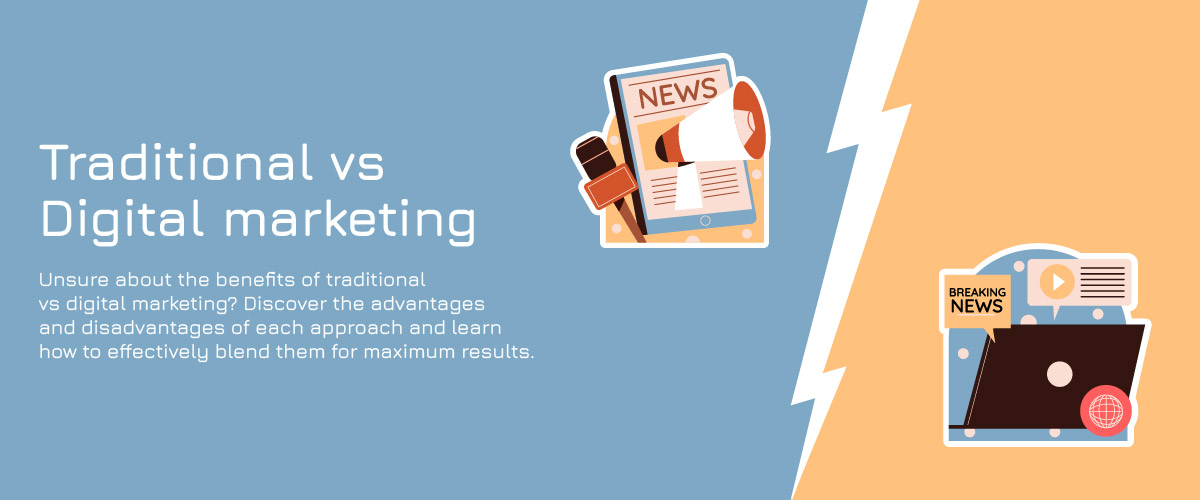Traditional Marketing Vs Digital Marketing
Marketing is one of the most crucial methods available to capture targeted customers’ attention. There are two popular methods of marketing – Traditional marketing and digital marketing. Along with technology, marketing has evolved from traditional to advanced digital aspects in recent years. Traditional marketing vs digital marketing, both methods have their own advantages and disadvantages, and businesses usually choose a mix of the two depending on the industry. Let’s understand the differences between traditional and digital marketing and figure out which marketing strategy would best align with your business strategy.
What is Traditional Marketing?
Traditional marketing is a conventional marketing method that can be performed without the Internet. Common traditional marketing platforms include print media, TV, magazines, hoardings, newspapers, radio commercials, and more. It works as one-way communication and reaches a larger audience to generate more leads.
Many people still see and hear these traditional advertisements every day on their TV, in newspapers, or when listening to the radio.
Types of Traditional Marketing
The following are the different forms of traditional marketing:
- Broadcasting: Broadcasting involves sending the same content to a large number of people through television and radio.
- Print Media: Print media includes paper publications circulated through newspapers, magazines, flyers, books, or journals.
- Telemarketing: Telemarketing, also known as inside sales, refers to phone calls and SMS sent to targeted customers to promote products and services.
- Window Displays and Signs: This traditional marketing method involves displaying products at the entrance or windows of a store.
- Outdoor Marketing: Any sort of outdoor advertising, such as billboards or hoardings attracting the public’s attention, is categorized as an outdoor advertisement.
What is Digital Marketing?
Digital marketing is an advanced form of marketing wherein marketers use the Internet to promote their products and services. The brand is promoted through advertisements, emails, blogs, influencers, web-based and mobile-friendly applications, and other paid promotions on social media.
Website content, content marketing, affiliate marketing, email campaigns, clickable ads, social media posts, etc., are some of the common digital marketing methods. With almost every person using the internet and social media, digital marketing has become the most effective tool to build a business or to create brand awareness. If you want to learn more about the various forms of digital marketing consider taking a digital marketing course.
Types of Digital Marketing
The following listed are different types of digital marketing:
- Social Media Marketing: Social media marketing is becoming popular among all generations. Many businesses are developing impactful social media marketing campaigns and advertising in the form of videos, audio, stories, and posts on multiple social media platforms.
- Content Marketing: Content marketing involves generating relevant, informational content and then sharing it with customers through websites or digital platforms.
- Email Marketing: Email marketing is all about sending marketing or promotional emails to the target customers.
- Search Engine Optimization (SEO): SEO focuses on optimizing content using various SEO tools and methods. This method is opted to make the content relevant for the target audience and generate organic traffic for the websites.
- Pay-Per-Click Advertising (PPC): PPC model allows marketers to pay only if a customer actually comes and clicks on their advertisements.
- Affiliate Marketing: Affiliate marketing is all about collaborating with individuals or businesses to help them generate traffic. Here, the affiliates receive a commission every time a customer clicks the link available on the affiliates’ page or blog.


Difference Between Traditional Marketing and Digital Marketing
It is essential to understand the difference between digital marketing and traditional marketing.
| Basics Of Comparison | Traditional Marketing | Digital Marketing |
|---|---|---|
Definition | It is a conventional method to grab the audience’s attention and create brand awareness using media, TV, magazine, one-to-one marketing, broadcasting, or referral marketing. | It is the modern, advanced method of grabbing audience attention towards a business using the internet, advertising, and various social media platforms. |
Communication | One-way communication | Two-way communication |
Engagement | Low | Relatively high |
Value of Trend | Targeted customers need to remember the trend. | Targeted customers can easily identify the trend. |
Nature | Static | Dynamic |
Targeting | Demographics or standardized | Customized based on customers’ attitude |
Targeting Difficulty | Difficult to target | Easy to target |
Effectiveness | Less effective | More effective |
Investment Returns | It’s difficult to measure ROI. | ROI can be measured easily anytime |
Being Viral | It depends on the effective presentation of marketing content. | It depends on trustful content and features of social media platforms. |
Tracking | Difficult to track | Easy to track |
Reach | Local | Global |
Tweaking | Difficult to change or edit once the advertisement is placed. | Easy to change or edit it anytime. |
Interruptions | The audience can’t ignore or skip the advertisement. | The audience can easily skip or ignore the advertisement if it doesn’t interest them. |
Results | Slow results | Quick and live results |
Opinion Leadership | The opinion of experts is important. | The opinion of customers is important. |
Content-type | Limited content created by experts. | Mixed content, including audio, video, graphics, blogs, posts, and more created by a creative team. |
Conversion | Slow | Extremely fast |
Cost | More expensive | Less expensive |
GET CONFIRMED 3.6 LAC SALARY by enrolling in our digital marketing course with placement guarantee.
Traditional Marketing Vs Digital Marketing: Pros And Cons
Let’s discuss the pros and cons of traditional and digital marketing:
Pros of Traditional Marketing
- Traditional marketing is impactful and easy to understand as striking TV commercials, or billboard advertisements are an integral part of people’s day-to-day lives.
- If a business wants to target an older demographic, then it should rely on traditional marketing methods.
- Conventional marketing is best suited for businesses that want to build a larger local audience.
- Traditional marketing content is easier to remember as TV and radio commercials are played several times a day.
Cons of Traditional Marketing
- Traditional advertisements, such as sending postcards or making personal phone calls to customers, can be a costly affair.
- Traditional marketing methods usually take a longer time to yield results and a survey is needed to know the effectiveness of advertisements.
- There is no direct interaction of sellers with the audience in traditional marketing which is easily possible with digital marketing.
Pros of Digital Marketing
- Digital marketing makes it easier to measure marketing efforts and know what people think of a brand. For instance, the more likes and positive comments that a marketing post or campaign receives, the more fruitful the marketing efforts turn out to be.
- Several social media channels are available to market a company’s products and services digitally.
- Digital marketing is more cost-effective as all it requires is an internet connection and an online presence.
- The scope of digital marketing is broad, so it allows companies to target global as well as scattered audiences.
Also Read: Benefits of Digital Marketing
Cons of Digital Marketing
- Some internet users use ad blockers to block pop-ups and banner ads. In addition, they can skip or ignore advertisements from their social media feed.
- Digital marketing efforts have a fleeting, temporary impact making them less permanent and easy to forget.
- With consistent upgrades on different digital platforms, marketers need to evaluate and re-evaluate continuously to maintain the effectiveness of a digital campaign.
Conclusion
It is safe to conclude that both types of marketing methods have their pros and cons. However, here the key is to understand traditional marketing vs digital marketing and your marketing needs, budget, and target audience to figure out the right marketing method for your business.
FAQs
The 4Ps of traditional marketing are product, price, people, and place.
Traditional marketing is mainly done through newspapers and magazines and has a wider set of target customers whereas digital marketing is done through social channels and is targeted towards a distinct audience.
Although it is difficult to determine the better ROI recent trends show digital marketing has a better ROI as it has a niche audience and also offers cost-effectiveness.
Traditional Marketing: Billboards, radio, television, newspapers, etc.
Digital Marketing: Emails, Text SMS, blog posts, etc.







